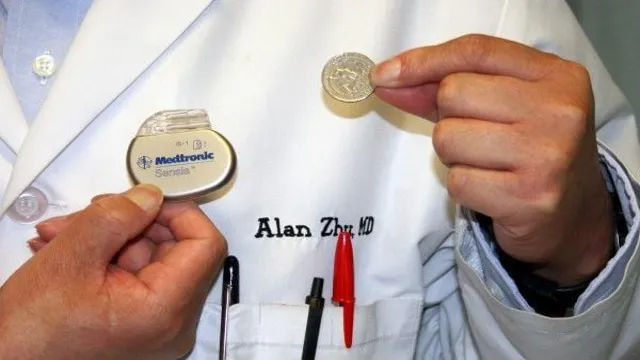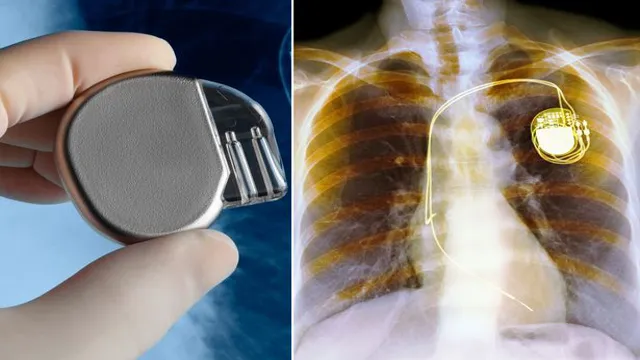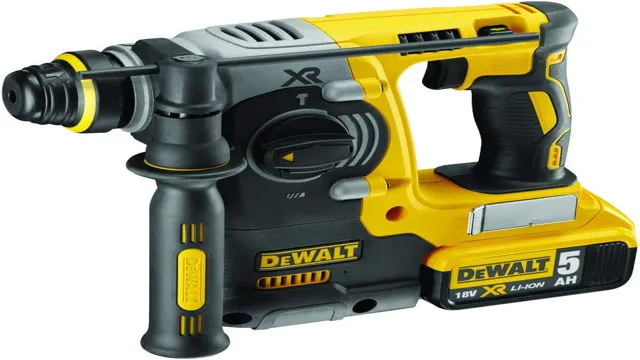Can a Cordless Drill Interfere with a Pacemaker? Understanding the Risks and Safety Measures

Have you ever wondered if using a cordless drill could be harmful to your health, especially if you have a pacemaker? While it is understandable to have questions about the potential risks of using electronic devices when you have a pacemaker installed, the good news is that there is no significant evidence to suggest that a cordless drill can cause any harm or interfere with your pacemaker’s function. In general, pacemaker users are advised to avoid prolonged exposure to devices that emit strong electromagnetic fields, such as MRI machines or welding equipment. However, most cordless drills used at home or in construction sites are not powerful enough to generate any significant electromagnetic interference.
The risk of injury or malfunction is also minimized by following standard safety precautions, such as wearing protective gear and keeping your distance from the drill bit. Some people might still feel nervous about using a cordless drill, but it’s important to remember that modern pacemakers are designed to withstand a wide range of interference sources and are tested thoroughly before they are implanted. In fact, pacemaker manufacturers go through extensive testing to ensure that their devices are safe and reliable in all types of environments.
Overall, using a cordless drill is generally safe for people with pacemakers. If you have any concerns about the safety of using a particular electronic device, it’s always a good idea to consult with your cardiologist or pacemaker technician. They can provide you with personalized advice and help you make an informed decision about your health and well-being.
Understanding Pacemakers
If you have a pacemaker, you may worry about possible interference from electronic devices around you. One common question is whether a cordless drill can interfere with a pacemaker. According to the American Heart Association, the electromagnetic fields produced by cordless drills are generally too weak to cause interference with pacemakers.
However, it is always best to take precautions and maintain a safe distance from any power tools or electronics that may emit strong electromagnetic fields. If you have concerns about specific devices, it is important to consult with your doctor to get their advice on any potential risks. Overall, while it is important to be mindful of potential sources of electromagnetic interference, most electronic devices are not likely to cause issues with pacemakers.
How Do Pacemakers Work?
Pacemakers are medical devices that are implanted in the chest to regulate heartbeat. These devices consist of a battery, a pulse generator, and wires that are connected to the heart. The battery powers the pulse generator, which emits electrical signals that tell the heart when to beat.
Pacemakers are used to treat bradycardia (a slow heartbeat) and other heart rhythm abnormalities. The battery in a pacemaker can last anywhere from five to fifteen years, depending on usage. When the battery runs low, the patient must undergo a procedure to replace the battery.
The pulse generator can also be programmed and adjusted by a healthcare professional to meet the patient’s specific needs. Although pacemakers are highly effective and safe, some people may experience complications or side effects, such as infection, bleeding, or device failure. However, these risks are relatively rare and can be minimized with proper care and monitoring.
In summary, pacemakers are a crucial medical device that helps regulate heartbeats in people with heart rhythm abnormalities. They consist of a battery, a pulse generator, and wires that are connected to the heart. Despite possible complications, these devices are safe and effective and can significantly improve a patient’s quality of life.

Types of Pacemakers
Pacemakers are medical devices that help regulate heart rhythm by sending electrical signals to the heart muscles. There are different types of pacemakers available today, each with unique features and benefits. The most common type is the single-chamber pacemaker, which uses one lead wire to send signals to the right atrium or ventricle of the heart.
Dual-chamber pacemakers, on the other hand, use two lead wires to send signals to both the right atrium and ventricle. They are often preferred over single-chamber pacemakers because they better mimic the natural pacing of the heart. Another type of pacemaker is the biventricular pacemaker, also called Cardiac resynchronization therapy (CRT) pacemaker.
This device uses three lead wires to send signals to both ventricles and the right atrium. It is typically used for people with heart failure to improve the coordination of heart contractions. Each type of pacemaker requires different surgical procedures and has unique features to meet the specific needs of the patient.
Knowing the different types of pacemakers can help patients and doctors choose the right device to address specific heart conditions.
Interference Risks
If you or someone you know has a pacemaker, it’s natural to worry about what types of electronics could potentially interfere with it. And while cordless drills may be a handy tool to have around the house, you might be wondering if they could pose a risk to pacemakers. The good news is that, in general, cordless drills are unlikely to cause problems for people with pacemakers – particularly if the drill is used at a safe distance from the device.
However, it’s still a good idea to exercise caution and avoid getting too close to the pacemaker when operating the drill. In some cases, particularly if the pacemaker is old or has a weaker signal, it may be more susceptible to interference from electrical devices. As always, it’s best to consult with your doctor or other healthcare provider if you have any concerns about the safety of using certain electronics around your pacemaker.
You May Also Love:
Electromagnetic Interference (EMI)
Electromagnetic interference (EMI) is a serious concern for many industries, especially those that rely on electronic components to operate. EMI can result in disruptions to the signal that electronic devices rely on, leading to malfunction or complete failure. For example, an electronic medical device that experiences EMI could misread vital signs, leading to incorrect diagnoses and treatment.
Similarly, an airplane’s communications system could malfunction due to EMI, leading to potential safety hazards. With so much at stake, it’s important that companies take steps to mitigate the risk of EMI. This can include shielding electronic components with materials that block EMI, separating sensitive equipment from sources of EMI, and testing devices to ensure they can resist interference.
By taking these precautions, companies can ensure that their electronic equipment operates smoothly and without interruption.
Examples of EMI
Electromagnetic interference (EMI) is a phenomenon that can affect a wide range of devices and systems, from consumer electronics to industrial machinery. There are many different examples of EMI that can cause interference risks, such as radiofrequency interference (RFI) from nearby radio transmitters, electromagnetic radiation from power lines, or electromagnetic pulse (EMP) from lightning strikes. These disturbances can disrupt electronic signals, causing loss of data or malfunctioning of equipment.
In addition, EMI can cause problems for wireless communication systems, such as cell phones or Wi-Fi routers. To avoid EMI risks, it is essential to shield electronic devices with appropriate materials, follow safety guidelines, and avoid placing equipment in areas with high levels of electromagnetic radiation. By taking these precautions, we can reduce the impact of EMI on our daily lives and ensure the smooth operation of electronic systems.
Pacemaker Interference from Household Items
Pacemaker interference is a major concern for people who have implanted cardiac devices. Household items can cause interference and lead to potential malfunctions of pacemakers. Electronic devices like microwave ovens, cell phones, and air conditioners emit electromagnetic fields, which can interfere with implanted cardiac devices.
It is essential for people with pacemakers to ensure that they stay away from such electronic devices or maintain a safe distance while using them. Additionally, some medical devices like magnetic resonance imaging (MRI) machines also pose a risk as they can cause interference. It is, therefore, crucial for healthcare providers to be aware of these risks and take necessary precautions to prevent interference from household items and medical equipment.
By being vigilant and cautious, individuals with pacemakers can minimize risks and ensure their safety.
Cordless Drill and Pacemaker Interaction
If you have a pacemaker, you may be wondering if it’s safe to use a cordless drill. While it’s unlikely to cause any issues, there is still a small potential for interference. Cordless drills, like many other electronic devices, emit electromagnetic fields that can affect the normal functioning of a pacemaker.
However, most modern pacemakers are designed with protection to prevent issues related to such interference. Therefore, the chances of a cordless drill interfering with a pacemaker are very low. Still, it’s always a good idea to keep electronic devices at least 6 inches away from your pacemaker to help lessen the risk of any potential interference.
It’s always best to consult with your doctor if you have any concerns about using electronic devices around your pacemaker.
Drill Companies’ Safety Measures
When it comes to safety measures, drill companies are constantly implementing new technologies and features to protect their customers. However, one interaction that many may not consider is between cordless drills and pacemakers. Due to the electromagnetic field that cordless drills emit, there is a potential risk of interference with pacemakers.
As a result, drill companies recommend that individuals with pacemakers avoid using cordless drills and opt for corded ones instead. It’s important to prioritize safety and take note of any warnings and precautions suggested by the manufacturer to ensure a safe and successful experience with your tools.
Precautions You Can Take
If you have a pacemaker and need to use a cordless drill, there are some precautions you should take to ensure your safety. Cordless drills contain strong magnets that can interfere with a pacemaker’s functionality and cause it to malfunction. To avoid any potential risks, it’s important to keep the drill at least 12 inches away from your pacemaker.
If you need to hold the drill closer, use your non-dominant hand to hold it and avoid resting it on your chest or near your pacemaker. You should also avoid leaning over the drill and ensure it’s turned off before bringing it near your body. It’s best to ask someone else to operate the drill for you whenever possible.
By taking these precautions, you can still use a cordless drill safely and avoid any risks to your pacemaker.
Conclusion
In short, it is unlikely that a cordless drill will interfere with a pacemaker. While the thought of a power tool disrupting a life-saving device is terrifying, modern pacemakers are equipped with advanced shielding that prevents most electromagnetic interference. However, if you still have concerns about using a cordless drill, it’s always best to consult with your healthcare provider for personalized guidance.
Remember, safety first – regardless of the task at hand!”
FAQs
What is a pacemaker?
A pacemaker is a small device that helps regulate the heartbeat in patients with heart conditions.
Can cordless drills emit electromagnetic interference (EMI)?
Yes, cordless drills can emit EMI which may interfere with electronic devices such as pacemakers.
How far away should a person with a pacemaker stay from cordless drills?
People with pacemakers should aim to stay at least 2 feet away from cordless drills to avoid any potential interference.
Can other power tools besides cordless drills interfere with pacemakers?
Yes, any power tool that emits EMI can potentially interfere with a pacemaker.
Are there specific types of pacemakers that are more susceptible to interference from cordless drills?
Yes, older pacemakers may be more susceptible to EMI interference.
What should a person with a pacemaker do if they experience symptoms of interference from a cordless drill?
If a person with a pacemaker experiences symptoms such as lightheadedness or dizziness while using a cordless drill, they should stop using the drill immediately and consult their doctor.
Are there any precautions a person with a pacemaker can take while using cordless drills?
Yes, people with pacemakers can use caution and try to avoid prolonged exposure to cordless drills. They should also be sure to follow any safety guidelines provided by the manufacturer.



